Going up against some real pros
- Share via
Dan McCoig was thrilled when he heard last fall that Doritos was soliciting regular folks to create a homemade ad for the snack to air during today’s Super Bowl.
Enticed by the year’s biggest advertising showcase -- 30-second spots on the Bears-Colts matchup are going for $2.6 million -- McCoig crafted nine commercials to post on the contest’s website. Among the Charlotte, N.C., resident’s subjects: a village for nutcrackers, hippies and a grandmother.
But a few days before the entry deadline, McCoig, 45, suspected that he was up against some ringers. This eventually was confirmed when the winners were announced.
Embarrassed by the high-quality, professional-looking commercials he saw popping up on the contest site, McCoig took down some of his own ads.
“I’m drawing chips in a bag; I’m drawing hippies,” he said. “What I should have been doing is renting a high-definition camera and hiring actors.”
The marketing world has been abuzz about the concept of consumer-generated ads, drawn to the democratic aura YouTube and other websites have created by letting anyone post videos.
Super Bowl advertisers such as Chevrolet, Alka-Seltzer, Frito-Lay and even the NFL itself got reams of publicity by asking people to audition their commercials in what has been portrayed as an advertising industry equivalent of “American Idol.”
USA Today told readers, “You could create Frito-Lay Bowl ad,” and a Reuters story said, “Jane and Joe get in on Super Bowl ads.”
But as McCoig and others discovered, the contests are looking more gimmicky than real as amateurs like himself are facing off against aspiring filmmakers and advertising professionals, who are coming up winners.
A man who works for a marketing company in Maine won the NFL contest. A radio DJ and former songwriter won the Alka-Seltzer contest in which contestants rewrote the lyrics to its classic “Plop Plop Fizz Fizz” jingle. And four out of the five finalists in the Doritos contest either are filmmakers, employed by advertising agencies or have produced commercials in the past.
Attracting pros to a contest billed as being for average Janes and Joes has generated controversy in the advertising world. After all, the competitions are overseen by ad agencies.
“It strikes me as a stunt,” said Brian Morrissey of Adweek.
Although he sees nothing wrong with companies trying to create buzz, Morrissey noted that “they’re not going to get true consumers or someone who’s just passionate about Doritos.”
But buzz goes only so far. Mark Stevens, author of the book “Your Marketing Sucks” and a blog about advertising, said sales of Miller Lite actually went down after its widely talked-about “Catfight” commercials in which two busty women slugged it out and lost articles of clothing while arguing about the beer.
True consumer-generated advertising is the kind spread in a guerrilla-like way through YouTube or word of mouth, not through competitions that are controlled by companies, said Joseph Jaffe, who runs the advertising blog Jaffe Juice.
“The organic kind is more believable and credible,” he said.
For these contests to be truly user-generated, Jaffe said, companies would have to take bigger risks than they are currently taking by letting consumers play with both the form and the content of advertising, rather than just create formulaic TV commercials.
By talking about turning advertising over to the public while not completely doing so, Jaffe said, companies may face a backlash.
The advertisers said they staged the contests to engage the general public.
“Our intent was to give the consumers their voice” and connect with people who are “passionate about the brand,” said Ann Mukherjee, vice president of marketing for Doritos owner Frito-Lay Inc.
NFL spokesman Brian McCarthy said the majority of contest entrants had a “passion for the NFL.”
Granted, engaging people in ad campaigns is important to agencies, said Jason Kuperman, director of Tequila, the interactive and entertainment practice at ad giant TBWA/Chiat/Day. “That is sort of the greatest compliment: that people will be involved and interested enough to engage in these campaigns.”
But it’s difficult to know if aspiring ad executives and filmmakers are the demographic group the companies are seeking. Many of the contestants say that they like the brand they created commercials for, but that fame and potential fortune prompted them to get in the contest.
“I entered because it seemed like a good opportunity to get more exposure,” said Scott Ippolito, a freelance filmmaker in Atlanta who spent $5,000 making his ads. “The film business is so competitive that everybody’s always looking for exposure.”
John Weaver, 32, head of John Weaver Productions, thinks it’s about time a contest like this came along for creative types.
“I’m not a jock, I’m not a prom king, and now finally there’s a contest that I have a chance at,” he said. “If someone else doesn’t think it’s fair, too bad.”
But being up against those with media savvy doesn’t sit well with Tim Knapp, the owner of a holography company outside Baltimore. He spent weeks making three commercials for the competition and barely saw his wife and children during the weeks leading up to the deadline.
Knapp, 34, even injured his foot during the long hours he spent cramped at a desk drawing one of his commercials, which was animated and featured ferocious winged monsters and a Doritos superhero.
In the week before the contest, he said, he knew he wouldn’t win when he saw the competition.
“It’s not a level playing field,” he said. “You kind of feel like you don’t have a shot.”



